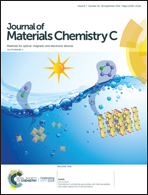Highly sensitive and wearable gel-based sensors with a dynamic physically cross-linked structure for strain-stimulus detection over a wide temperature range†
Abstract
Traditional hydrogel sensors can only be applicable in a limited temperature range, such as ambient temperature, since water is easily frozen or evaporated under extreme conditions, which seriously affects their practical application. Here, a highly sensitive wearable strain sensor is fabricated from a flexible, self-healing, anti-freezing and anti-drying gel with a physical cross-linking structure, which is composed of polyacrylic acid, chitosan, and graphene oxide in a mixed solvent of water and glycerol. The dynamic cross-linking enables the network structure and ion channels of the gel to be rapidly recovered and reconstituted, thereby allowing the gel-based strain sensor to display excellent stretchability (more than 1000%) and outstanding sensing performance with a rapid response time of 40 ms, and remarkable repeatability and stability. As a result, the gel can be applied as an epidermal strain sensor for real-time detection of human motions, including joint motions, speaking and breathing. Moreover, the gel can maintain excellent flexibility, stretchability and conductivity over a wide temperature range from −20 °C to 70 °C, which effectively improves the practicality and durability of the gel in practical applications. Therefore, such flexible, conductive, anti-freezing and anti-drying gel may have promising applications in the field of wearable devices, soft robot systems and other applications that need to be applied under changeable conditions.



 Please wait while we load your content...
Please wait while we load your content...